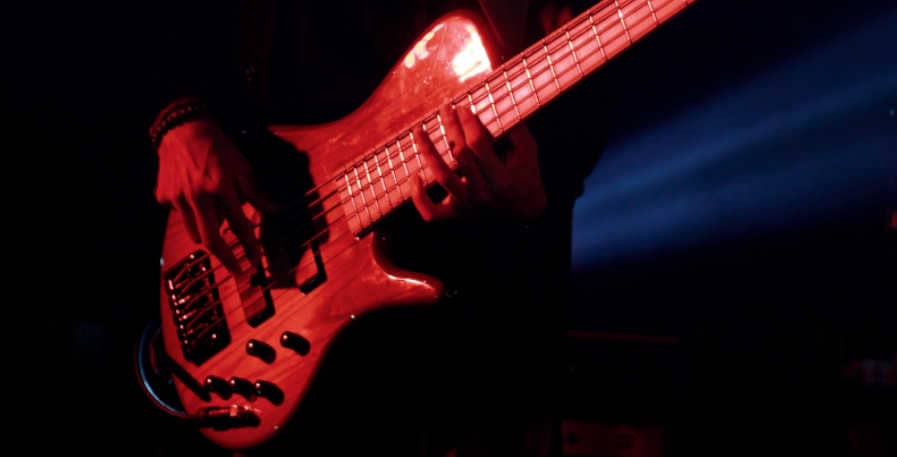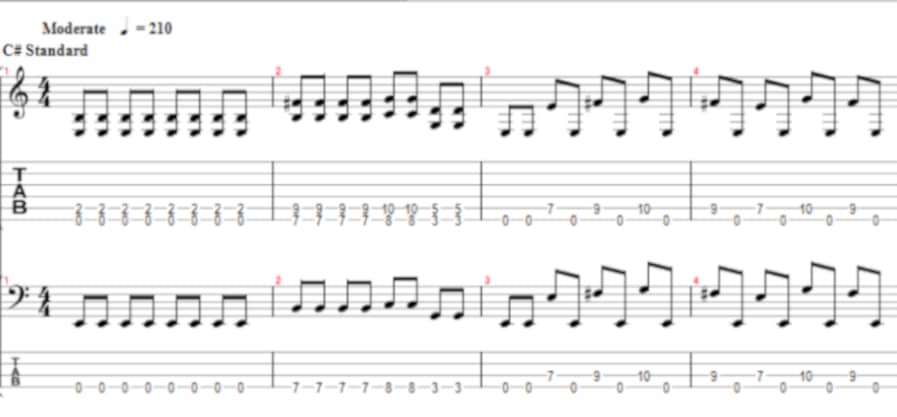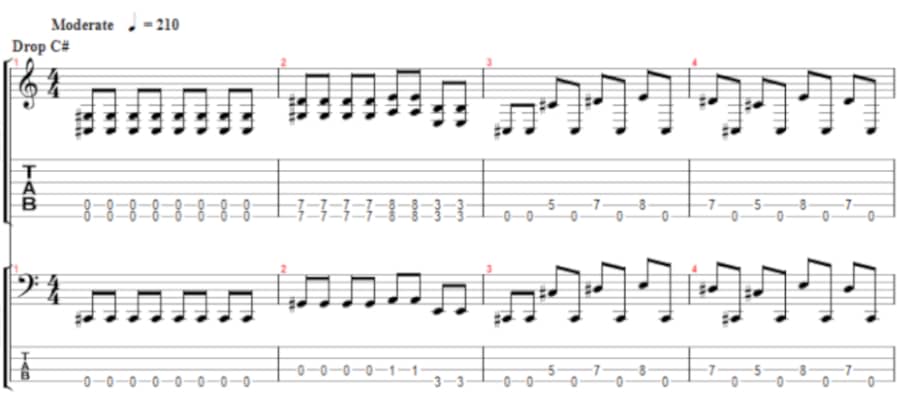This post contains affiliate links
Out of all the alternate bass tuning I`ve tried, C# standard is my favorite. This is in large part because I love the melancholy feel of the C# minor scale, which sounds all the more powerful in heavier genres of music.
However, C# is a tuning that is often both overlooked and not used to its full potential by bassists. This is because musicians often ignore half-step tunings in favor of tunings such as C standard. This results in a lack of information on how to properly set up for and utilize the tuning.
Therefore, I have written down everything you need to know about the C# standard tuning for the bass guitar. You will learn how to tune both a 4-string and a 5-string bass to it, and I`ve made a tuner you can use on this page.
You will also learn what you need to be mindful of when tuning down 1 and a half steps, and what type of strings are needed to sustain the new tuning. I will also showcase the difference between C# standard and drop C#, and show you some bands that have used the tuning to great effect.
What is C# standard tuning?
In C# standard tuning, the strings are tuned C#, F#, B, and E from low to high on 4-string basses. 5-string basses can be tuned C#, F#, B, E, A, but bassists generally elect to play in B standard instead of tuning up to C#.
C# is similar to E standard in that all the strings are tuned at perfect fourth intervals. The tuning differs from E in that it has a deeper range, and can thus be used to attain a heavier and more powerful sound.
In terms of popularity, C# standard is a less used alternative tuning. It is a unique tuning that works great for songs that have a sorrowful and sad character to them. The tuning has thus been used to great effect by symphonic metal, melodic death metal, and progressive rock acts.
Here are some of the main reasons bands elect to use C sharp standard over other tunings:
- It`s heavy – Most bands that tune down their instruments, do so to sound heavier. C sharp standard is no exception, and you will find that the majority of bands that play in C# are metal or rock acts. B, C, and C# are all great middleground tunings, that are not excesively deep, but not too reminiscent of E standard either.
- Unique sound – Deviating from E standard will make you stand out. Choosing to play in C# in particular will make you stand out even more. It is an uncommon tuning, as most bands that tune down play in D or C. Furthermore, 5-string bassists and 7-string guitarists tend to tune to B or A. As a result, C sharp allows you to really stand out as a bassist or as a band.
- Emotional – I have always found C# minor to be a particularly melancholly scale. Therefore, C sharp is the perfect tuning for anyone looking to incorporate sad and emotional melodies into their heavy sound. For this reason, you will find that many bands that play in C# sharp have a big emphasiss on melody.

How do I tune my bass to C# standard?
In order to tune a bass to C# standard, tune every string down 1 and a half steps down from E standard. The best way to do this is by using a chromatic tuner, as this will ensure you are perfectly in tune. Alternatively, you can use a non-chromatic tuner or a piano.
If it’s your first time tuning to C sharp standard, I recommend using a chromatic tuner for several reasons. Depending on your pitch, your ears could struggle with the low C# string, especially if you haven’t tuned this low before.
Most bass tuners are chromatic, meaning that they show you exactly what note is being played. If you do not have one, you can use an online bass tuner instead. The microphone might struggle to pick up your deepest string. If this happens fret it at the 12th fret while tuning the string to C#. This is the octave and should have the same pitch as an open string.
If you are comfortable using your ears to tune your bass, most methods that work for tuning your bass to E also work for tuning to C#. For a quick and easy way, use the tuner below.
If you listen to the C#, F#, B, and E in succession, you should notice a familiar pattern. These notes are perfect fourths apart, just like E, A, D and G are in E standard.
Thus, you can play any bassline that is written for E in C sharp as well. The bassline is going to be the same melodically; it will simply sound deeper and be in a different key.
What happens when I tune my bass to C# standard?
Tuning down 1 and a half steps will affect your bass guitar in a multitude of ways. Here are some of the main things you should be mindful of when tuning to C# standard:
- String gauge – It is possible to tune to C sharp standard without switching to a heavier string gauge. However, the tone of your bass will be powerless and clanky if your strings are too loose. How big of an impact this will have depends on your current string gauges, but switching to a heavier set is a best practice. More on string choice later.
- Action – You can expect the action on your bass to raise somewhat when you tune it down to C#. Depending on your strings and setup, the change should not be major and you can retain a low action in most cases. However, do expect to notice a slight difference in playability and tone as a result of this.
- Tuning – If your bass is used to being tuned to E, it will take some time for it to adjust to C#. This simply means that you will need to tune your bass more regularly after you first tune down to C#. In time your bass will adjust, and you will need to tune your instrument less frequently.
- Neck Relief – When switching to a heavier set of strings, the neck relief of your bass will be affected. This can be solved with a truss rod adjustment and will not damage your instrument. However, you should be mindful of this and monitor your neck relief after you tune down.

What bands use C# standard tuning?
Below is a list of various bands that have utilized C sharp standard either as their main tuning or as a major part of their discography. I`ve listed artists from a wide range of genres, but you will find that most play sub-genres of metal.
It`s also worth noting that fan tabs are notorious for being filled with mistakes. This holds especially true when it comes to less-used alternative tunings, such as C# standard. My recommendation is thus to always cross-reference tabs in C# standard when exploring tabs or notations on your own.
| Band | Bassist | Genre | Songs in C# standard |
| Dark Tranquility | Various. Martin Henriksson (1989-1999 and 2013-2015) | Melodic Death Metal | “The Poison Well”, “Identical To None” |
| Disturbed | John Moyer | Alternative Metal, Nu Metal | “Stupify”, “Down With The Sickness” |
| Black Sabbath | Geezer Butler | Heavy Metal, Rock | “Snowblind”, “Sabbra Cadabra” |
| Therion | Various. Nalle “Grizzly” Påhlsson (Since 2008) | Symphonic Metal | “Son Of The Sun”, “The Khlysti Evangelist” |
| Limp Bizkit | Sam Rivers | Nu Metal, Rap Metal | “Rollin`”, “Ready To Go” |
| Between The Buried And Me | Dan Briggs (since 2005) | Progressive Metal | “Memory Palace”, “Selkies The Endless Obsession” |
| Gizzard & The Lizard Wizard | Lucas Harwood | Progressive Rock, Psychedelic Rock | “Crumbling Castle”, “Planet B” |
| Behemoth | Tomasz “Orion” Wróblewski (since 2003) | Blackened Death Metal | “Conquer All”, “Blow Your Trumpets Gabriel” |
| All That Remains | Aaron Patrick (2015-2021) | Heavy Metal, Metalcore | “Chiron”, “Two Weeks |
| My Dying Bride | Lena Abé (since 2007) | Doom Metal, Gothic Metal | “My Wine In Silence”, “And My Father Left Forever” |
What bass strings to use for C# standard
A balanced set of bass strings for C# standard has gauges of 115-95-75-55. These gauges can be adjusted slightly for a thinner or heavier sound, and heavier gauge strings are commonly used for the low C#.
String manufacturer Ernie Ball recommends a set of 110-90-75-55 for Drop C and Drop D. For Drop B they recommend a set of 125-95-75-60. This means that for C# standard their recommendation would roughly be 110-95-75-60.
Related reading: My Complete Guide to Drop D
For the 3 highest strings on a bass this is a fit recommendation. However, few bassists use a string as thin as 110 for their deepest string when they play in C# standard. Your bass would still be playable with a 110 gauge C# string, but I recommend getting either a 115 or 120 gauge.
This holds especially true if you are looking to play metal or any kind of heavy genre. This is because a heavier string gauge will provide a heavy, rumbling, and more powerful sound.
I also recommend using round wound strings for C# standard if you are looking to sound heavy. While flat wound strings can sound great, their warm and smooth character is generally unfit for genres that typically utilize C sharp standard.
Roundwounds are more fit for a heavy sound as they provide a good balance of lows, mids, and highs. They also have less of a musky sound, which is something bassists generally want to avoid when tuning down.
For these reasons, I recommend this string set from DR Strings for C# standard. It is a 115-95-75-55 set of round wound strings that come in a corrosive proof package, which ensures your strings arrive in good condition.
I have used DR strings for multiple alternate tunings in the past when playing both melodic death metal and garden-variety heavy metal. I found their sound to be suitable and heavy and would highly recommend the brand in general for anyone who is looking to play heavy genres in an alternate tuning.

C# standard vs drop C#
In C# standard every string is tuned down one and a half steps from E. In drop C#, only the deepest string is tuned one and a half steps, while the reaming strings are tuned down just a half step. Drop C# thus means that the strings are tuned C#, G#, C#, F#.
Whether to use Drop C# or C# standard largely depends on what type of music you are looking to play. If you are in a band, it also largely depends on what type of tuning you collectively want to use.
Drop C# provides 1 whole step of more of high range than C# standard, while the low range is the same. This is rather insignificant, and the main difference between the tuning lies in how riffs differ in playability. Here is a chord progression and riff for the bass and the guitar in C# Standard:

This type of bassline will not be too different in C# standard or drop C#. Depending on the riff, it can be more challenging to play in one of the tunings. However, riffs are very rarely unplayable in one tuning and not the other.
Guitarists might prefer tuning to drop C# as it makes power chords easier to play. Look at the first two bars of the guitar part above and notice how two fingers are needed to play the power chords.
Related reading: Playing power chords on the bass
Below the same riff and chord progression is played in Drop C# on the bass and guitar. Notice how the guitarist only needs 1 finger to play the same progression:

Notice how the bass part has also transposed as a result, but the difficulty of it largely remains the same.
Thus, on your own, whether you prefer to play in C# standard or drop C# largely comes down to preference. In a band, it is helpful for all the members of it to play in the same tuning. You don`t have to, but using the same tuning means you don`t have to think about transposing parts, and it becomes easier to share ideas.
C# standard tuning for 5-string basses
A 5-string bass can be tuned up to C#-F#-B-E-G# to support a C# standard tuning. Alternatively, it can be tuned down to G# Standard for a G#-C#-F#-B-E tuning where the 4 highest strings are tuned the same way as a 4-string bass is in C# standard.
For 5-string players looking to play in C# standard, the first question to ask yourself is whether you should tune your bass at all. 5-string basses are normally tuned to B standard, which will often be sufficient to play songs that are written for C# standard.
Related reading: Do you need a 5-string bass for metal?
The two reasons it would be worth tuning to C# standard or G# standard are the following:
- Riffs utelize the open C# string a lot – Riffs such as the one demonstrated above will be difficult to play in B standard. This is because every note would need to be fretted, and you cannot ride the open C# string while fretting notes on the F# string. Thus, if you play music that incorporates riffs that use the open string a lot I would tune up to C#.
- Dealing with transposing – As stated above, if your guitar players are playing in C# and you are playing in B, a good bit of transposing will need to be done when writing music. The fact that you are both playing in a standard tuning, just 1 whole step apart, will make this easier. However, if you do not want to deal with transposing at all, it can be preferable to just stick to the same tuning.
If you tune a 5-string bass up to C# standard you can use the same string gauges as recommended for 4-strings above. For the high G#, a string gauge of either 40 or 45 will make for a balanced set in this case.
If you decide to tune to G# standard instead, you will need a heavy set of strings. For A standard I recommended a set of 145-75, and you will want to go slightly heavier than this for G#. Your bass will also benefit greatly from a setup if you decide to tune this low.
Conclusion
C# Standard is the perfect tuning for bassists who are looking to sound heavy and unique. This holds especially true if you like melodic genres, as it allows you to play heavy riffs that utilize the open C# string to truly bring those melodies to life.
If you are tuning down to C# from E, you will need a fitting set of strings. I also recommend setting up your bass or paying a luthier to do it for you. When I compared the cost of different luthiers, I found that the average cost of a setup without strings included is $63.18.
It is preferable to play in C# standard if your band commits to playing in the tuning together. However, it is possible for both 4-string and 5-string players to play in a different tuning even if the rest of the band is playing in C# standard.
Bear in mind, this will result in you having to transpose riffs, and could lead to some riffs becoming difficult to play. If you are playing alone, the difference between C# standard and drop C# is mainly a question of preference, and what artists you are looking to cover.

